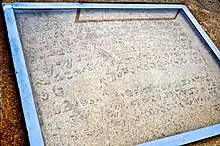Odegal basadi
Odegal basadi or Vadegal basadi is the largest basadi located on the Vindhyagiri Hill in Shravanabelagola in the Indian state of Karnataka.
| Odegal basadi | |
|---|---|
.jpg.webp) Odegal Basadi | |
| Religion | |
| Affiliation | Jainism |
| Deity | Rishabhanatha, Neminatha, Shantinatha |
| Festivals | Mahavir Jayanti |
| Location | |
| Location | Shravana Belgola, Hassan, Karnataka |
| Geographic coordinates | 12°51′18″N 76°29′06″E |
| Architecture | |
| Style | Dravidian architecture |
| Date established | 14th century |
About temple
Odegal basadi is a granite temple built in 14th century and is the largest temple on the Vindhyagiri Hill.[1][2] The temple derives its name from 'Odega', i.e., soapstone used for strengthening the walls of the temple.[3] The temple has three cells facing different directions, giving the name Trirukta Basadi or trikuta Basadi.[4] The temple has splended structure with non-ornate exterior.[5] The temple houses image of Rishabhanatha, Neminatha and Shantinatha made out of dark coloured schist.[1][6] This temple is include in Adarsh Smarak Scheme introduced by Archaeological Survey of India for the preservation.[7]
The Gommateshwara statue, Siddhara basti, Chennanna basti, and Chauvisa Tirthankara basti are the important temple near Odegal basadi.[8]
Gallery
 Kannada inscription
Kannada inscription Adinatha statue
Adinatha statue Shantinatha statue
Shantinatha statue Neminatha statue
Neminatha statue
References
Citations
- Deccan Herald 2020.
- Raman 1994, p. 57.
- Settar 1989, p. 269.
- Menon 2018.
- Sangave 1981, p. 14.
- Knapp 2008, p. 496.
- ASI & Adarsh Smarak Monuments.
- Rao 2020, pp. 14-15.
Sources
- Knapp, Stephen (2008), Seeing Spiritual India, iUniverse, ISBN 9780595614523
- Raman, Afried (1994), Bangalore - Mysore, Bangalore: Orient Blackswan, ISBN 9780863114311
- Sangave, Vilas Adinath (1981), The Sacred ʹSravaṇa-Beḷagoḷa: A Socio-religious Study, Murtidevī granthamālā, 8, Mumbai: Bhartiya Jnanpith, ISBN 9789326355599
- Settar, S. (1989), Inviting Death: Indian Attitude Towards the Ritual Death, Monographs and Theoretical Studies in Sociology and Anthropogy, 28, Mumbai: BRILL, ISBN 9789004087903
- "Architecture of serenity in the hills". Deccan Herald. 23 August 2010. Retrieved 23 December 2020.
- Menon, Srikumar M. (12 February 2018). "Rite sacred bath". Deccan Herald. Retrieved 23 December 2020.
- Rao, Nalini (2020). "New Perspectives on Jain Architecture and Sculpture at Shravanabelagola". Buddhist Studies Commons, Hindu Studies Commons, History of Religions of Eastern Origins Commons. 2 (3). Shawnee State University. Cite journal requires
|journal=(help) - "Adarsh Smarak Monuments". Archaeological Survey of India, Bengaluru Circle. ASI Bengaluru Circle. Retrieved 22 December 2013.
External links
 Media related to Odegal Basadi at Wikimedia Commons
Media related to Odegal Basadi at Wikimedia Commons